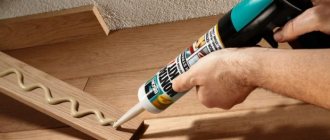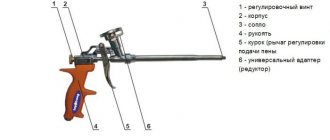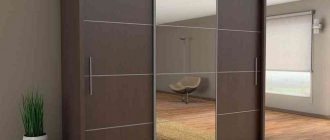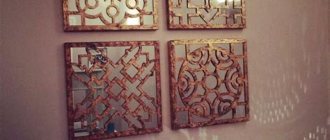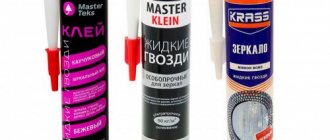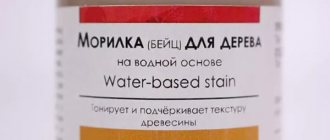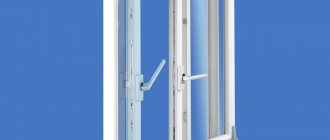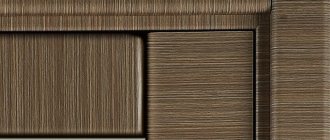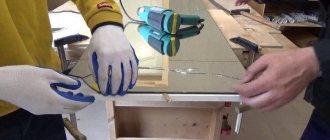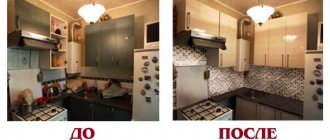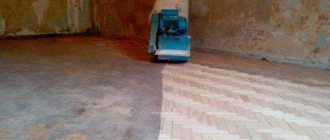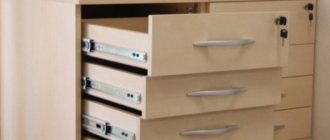Sometimes things happen that make a mirror on a closet, for one reason or another, need to be removed and replaced to avoid trouble. If a chip has formed on it, hopelessly spoiling the appearance, or a crack, it is better not to keep such a thing in the house and try to replace it with a new one as soon as possible.
In such a situation, your mirror not only spoils the appearance of the interior, but also becomes a direct threat to the residents, especially if there are small children in the house who are fond of active games. You can get rid of a cabinet decor element that has become superfluous in several ways, depending on the fastening, and the main tool is you and your hands. Our article is about how to peel off a mirror from a cabinet, remove it from a wall, or separate it from a wardrobe door if it was glued with liquid nails, double-sided tape or other glue.
If you do everything correctly, you will easily cope and will not spend a day waiting for a specialist and, most importantly, money.
Is it possible to peel off an extra decorative element yourself?
The answer is clear: yes.
But for beginners, the process is quite labor-intensive and requires high concentration and careful attention, so it is better to arrange for yourself an environment in which nothing can distract you. If you follow all the rules, follow safety precautions and follow the recommendations, you can remove the mirror at home in half an hour or less , but in cases of difficulties or complex fasteners, it is better to contact specialists with experience in such work with this issue.
Ethyl or ammonia
It is recommended to apply ethyl alcohol to a cotton-gauze swab or cotton pad. Then you need to scrub the area until all the dirt is gone. An important condition in this case is the timely replacement of dirty swabs with clean ones, since the speed of the cleaning process depends on this. Ethyl alcohol affects the adhesive tape base at the molecular level, destroying its structure.
In addition to ethyl alcohol, you can also use ammonia. It acts similarly to ethyl alcohol. The difference is a sharp, unique smell that dissipates fairly quickly.
According to experts, fresh marks left after removing double-sided tape are easier to remove than old stains. The older the stain, the more it is absorbed into the underlying material, and accordingly, the more difficult it will be to remove it without leaving a residue. In addition, adhering dust and other small particles significantly complicate the cleaning process and restoring the original condition of the affected area.
For old marks, heating procedures are well suited if the characteristics of the material on which the tape was fixed allow this.
How to remove a mirror glued with silicone or double-sided tape. Well, you never know, for whatever reasons, whether the form didn’t suit the client, or something else, it doesn’t matter, but it needs to be removed...
Then you will need:
- rubber hammer,
- metal carpenter's ruler 1 meter long.
Any adhesive connection, and especially adhesive tape, has its own thickness, that is, there will always be a couple of millimeters between the mirror and the chipboard.
What is the best way to disconnect?
- The first method is suitable for cabinets from which the door can be removed. Do not remove the mirror when it is in a vertical position, as you may break it and injure yourself.
- For the second method, you will need wire, and it works like this: with movements to the left and right, you need to cut off both the layer of liquid nails and other adhesive mass that attaches your mirror to the cabinet. This option is very convenient and the safest: nothing will burst or crack if you do not overdo it with sharp movements.
- The third method is intended for a wardrobe, when working with which it is especially recommended to be more careful and adjust the level of brute force if the mirror is not to be damaged.
Methods for attaching mirrors to the wall
So, you bought a mirror, but don’t know how to hang it on the wall? Follow our recommendations carefully and you can hang a mirror yourself without breaking the bank. Frameless mirrors are very popular now, and we will deal with this case first.
For all types of installation, prepare the following tools:
First of all, it is important for us that the mirror hangs evenly. To do this we will use a level. The level may be large, or it may be small. By the way, modern technologies make it possible to use even a virtual building level for leveling. To do this, download the appropriate application from PlayMarket or AppStore.
Also, it will be more convenient to install with a suction cup handle for glass. With its help, you can carry the mirror without fear of breaking the canvas. In addition, in all methods except gluing, you will need a screwdriver with a drill of the required thickness for your base.
Mirror glue
The advantage of the gluing method is that you do not need to drill holes in the wall. The adhesive composition will perfectly hold the mirror even on surfaces such as tiles and laminated MDF. At the same time, keep in mind that the wall on which the product will be located must be level. In addition, ordinary superglue or sealant will not be suitable for these purposes, since it contains substances that corrode the reflective layer of the mirror.
If you are gluing a mirror to a wooden surface, it is better to use a combination of glue and several strips of double-sided tape.
Step-by-step algorithm of actions:
- From the section of the wall on which the mirror will hang, it is necessary to remove decorative finishing - wallpaper, paint or plaster. Cover the wall with primer, dry and degrease.
- Also degrease the back surface of the mirror. Apply glue according to the diagram in the illustration above. For stronger adhesion, apply glue to the placement site as well.
- Together with an assistant, quickly and carefully lift the mirror and install it in its place.
- Secure it from the outside with masking tape. After 3 days, the mirror will be completely dry and the insurance can be removed.
Mirror holders
Installation on holders is good because the mirror can be removed and moved to another place at any time. In addition, the holders are best suited for mounting on uneven walls.
In this method, holders are first mounted into the wall, and then the canvas itself is inserted into them. It is more convenient to start installation from the lower holders, because they are the very base that will hold the mirror.
Step-by-step algorithm of actions:
- Place the mirror against the wall. Level it using a level and use a pencil to mark 4 points into which the fasteners will be screwed. Typically, two holders are used at the bottom and two on the sides of the mirror.
- Using a drill, drill the required holes in the wall.
- Insert the screws into the special holes on the fasteners. Attach the holders to the wall using a screwdriver.
- Together with an assistant, carefully lift the mirror and install it in its place. Cover the fastening area with decorative covers. Ready!
Dowel mounting
This method is intended for mirrors on which 4 holes have already been made by a master glazier, and is considered the most reliable of all. If there are small children in the house, it is better to choose this one.
I would like to point out right away that it is absolutely forbidden to drill holes on the mirror surface yourself! Your mirror will simply crack, so it's best to take it to a glass shop to create the holes.
Step-by-step algorithm of actions:
- Place the mirror against the wall. Level it using a level and mark 4 points on the wall with a marker into which the screws will be screwed.
- Leave the mirror, drill the necessary holes in the wall with the depth of the dowel. If the wall is made of brick, plasterboard or wood, a regular drill can handle this, but if it is made of reinforced concrete, you will need a hammer drill.
- Insert plastic bushings into the holes so that they do not protrude beyond the plane of the wall.
- Together with an assistant, carefully lift the mirror and screw the screws into the created base. The important role of the assistant is to hold the mirror while you screw in the screws. Put on the decorative caps and you're done!
Plates for mirrors
One of the reliable methods for concealed mounting of mirrors is metal plates. They are made of galvanized metal, so they are not subject to corrosion and are suitable for use in the bathroom. But one plate can only support a weight of up to 6 kg, so this installation method is not suitable for large, heavy products.
Anchor hooks are screwed onto the wall, and plate holders are glued to the back of the mirror. Attention! For this purpose, special glue for mirrors is used so as not to damage the amalgam. To prevent the mirror from breaking into small pieces in case of injury, it is recommended to stick a protective film on the back side of the amalgam.
Step-by-step algorithm of actions:
- Degrease the back surface of the mirror and the glued side of the plate. Connect them with glue and leave for a day.
- Place the mirror against the wall. Level it using a level and make pencil marks in accordance with the location of the glued plates.
- Screw the anchor bolts into the wall with a drill and hang the prepared structure on them. Ready!
Mirror fittings
Clamps, strips, staples, brackets, profiles - there are a lot of types of accessories for fastening mirrors, you can choose the one that suits you best in design and style. It is advisable that the staples are 5-7 cm from the edges of the mirror.
The profile method involves attaching a metal strip to the wall into which a mirror is inserted. So it is fixed at the bottom, and at the top there is usually a hook or the canvas is glued to liquid nails.
The hardware method involves creating four holes in the wall. First, self-tapping screws are screwed into the holes created in the wall, and then the mirror sheet is carefully inserted into the grooves of the fasteners.
Mirror in frame
Hanging a framed mirror on the wall is an easier task than the previous ones. Most often, these mirrors already have D-rings or hooks. You will only need to provide a mate - two or more hooks. The number and power of fastenings are selected according to the weight of the product, as well as the supporting wall. For example, for plasterboard walls it is better to use so-called “butterfly dowels”.
Rope suspension
In some interior designs, such as loft, Provence or country, this installation method would be appropriate for round mirrors. A cord or rope brings a special zest to the interior of a room, and it’s not difficult to create this original frame yourself.
Step-by-step guide on how to remove unwanted surface
Method number one:
- Using a screwdriver, remove the cabinet element on which the mirror to be removed is attached, holding it and twisting the fasteners.
- Place the door on a horizontal surface that is most comfortable to work on.
- Take a metal ruler and sharpen it at the narrow end using sandpaper - this will be the main thing.
- Cover the mirror with tape so that the fragments do not fly to the sides and into your eyes, this way there will be less debris around.
Important: the more free space, the less likely it is to make a mistake.
Do not overdo it! Do not lift the ruler too high and tap it carefully so that the mirror does not crack.
How to remove?
Before you begin removing double-sided tape, you must carefully read the instructions and removal tips, because any careless movement can ruin the surface on which traces of the tape are located.
There are dozens, maybe hundreds of methods for removing adhesive marks, but the most effective ones are revealed below. Let's look at each of them in more detail.
Stationery knife
The method is simple, but it is permissible to use it if the likelihood of scratching the surface is minimal .
Proceed with caution. The paper or film base is pryed off with a blade. The loose edge of the tape can be easily torn off by hand.
If it was not possible to remove all the adhesive tape at once, and pieces remain, you need to lift the edge of the adhesive tape again with the tip of a knife, and so on until it is completely removed.
Rubber (caoutchouc) disc
A soft attachment for a drill or screwdriver will help you cut off adhesive tape from a large area . The rubber disc will remove the top sticky layer without leaving scratches on the surface.
The tool must be set to minimum speed. Plastic rubber will not harm even the paintwork.
Glue heated to 80-100°C is removed faster. You can use either a hair dryer or a hair dryer to dry your hair. They can be replaced with an iron set to the minimum temperature.
The advantage of this method is the absence of scratches even on paper . The most tightly attached tape can be removed without difficulty.
But there is no need to heat non-heat-resistant objects to high temperatures, especially with a powerful hair dryer - they will immediately deform. It is better to expose them to the sun for a short time or keep them under steam - the glue will noticeably soften.
Oil
The glue will easily slide off if you lubricate the area of contamination with vegetable or essential (for example, eucalyptus) oil . They contain organic unsaturated acids that can dilute polymers:
Wipe the sticky surface with a sponge and leave for several hours.- You can lay a rag soaked in oil on a horizontal tabletop or bedside table for about 20 minutes.
- If the stain is stubborn, it is best to leave the greased stain on overnight. In the morning the stain will come off without effort.
- All that remains is to wash off the oil. Easy to clean surfaces (glass, polished furniture, plastic) do not absorb grease, so there will be no problems.
This method is not acceptable for paper wallpaper.
Eraser
If you rub the remaining glue with a regular eraser, it will form pellets and come off easily . Just rub it with a cloth.
Gasoline, acetone, white spirit
The main advantage of the method is the ease and speed of removal:
How to cut or tear off a mirror panel glued with double-sided tape from a door?
Double-sided tape does not seem as impressive as liquid nails, but this is not entirely true, because the mirror can be glued to it not only in the middle and along the edges, but also over the entire area. If desired, the mirror can be torn away from its mounting location, but there is a high risk of breaking the thing and injuring your hands with large fragments, so it is better to discard this method immediately and not try to use it under any circumstances.
A good way to remove a mirror from double-sided tape is similar to the one described above using cutting wire. If you don’t have an item for exactly this purpose, you can take a strong string or any thin but strong wire that will pass between the mirror and the door and will not break during the sawing process.
How to carefully remove a glued mirror from the wall without breaking it?
The mirror was glued to the wall rather than mechanically attached.
How to carefully remove a glued mirror from the wall without breaking it?
comment to favorites bonus Kim Jong-un [412K] over a year ago
It is important to consider what exactly the mirror was glued to the wall, as well as the material used to make the wall.
The mirror can be glued with special glue for mirrors, or with sealant, with double-sided tape, or with tile adhesive.
In the case of tile adhesive, it is almost impossible to remove the mirror without leaving it intact (for example, the walls were tiled and the mirror was glued to the tile adhesive flush with the tile).
Some (but not all) glue softens when exposed to temperature.
You need a hair dryer; a regular household hair dryer will do.
Just in case, I advise you to cover the mirror with strips and masking tape; if it breaks, it will not fly apart into small pieces.
Next, you need an assistant, he holds the mirror (especially if we are talking about a large massive mirror, then you cannot do without an assistant).
We warm up the surface, then insert this string between the mirror and the wall
with handles (this is a finished product, a string knife, although an ordinary guitar string will do), or strong wire and cut the softened glue, remove the mirror.
Instead of strings and wires, you can try inserting a metal ruler between the wall and the mirror and trimming the adhesive layer.
If the glue is applied only in the corners (at the corners) of the mirror, then you can get by with a spatula.
The sealant (string, ruler) is cut in the same way, only it does not need to be heated with a hairdryer.
That's it, then carefully lower the mirror down from the wall, clean it of any glue residue (the same as the wall).
If the mirror was glued to the drywall, then local repairs are possible after removing the mirror.
If you use double-sided tape, then the string is not needed, carefully pry the mirror up in the corners with a spatula and remove the mirror from the wall.
And in this case, you can use a hair dryer (it will soften the adhesive layer on the tape).
How to remove marks on the wall after dismantling?
Once the mirror has been removed, you can begin to peel off the old adhesive layer . You can do this in the usual way, using a spatula or knife, if this place then covers the mirror again. To preserve the surface and not scratch it, you can use the second option: here the main assistant is gasoline or solvent.
The solution with dissolution is more successful if there is information about the composition of the glue. You need to apply a solvent to the surface of the cabinet and wait until it softens the glue and allows it to be wiped off. You can stick a new mirror onto the cleaned area, but this must be done carefully so as not to break it.
How to properly glue a mirror onto liquid nails?
I want to install a mirror in the bathroom on a tiled wall. How to properly glue it to liquid nails so that it doesn’t fall off later?
comment to favorites Anatm ar [54.6K] 6 years ago
First you need to degrease the tiles where the mirror is installed. This can be done with a water solution of soda, and then rinse it with clean warm water.
Liquid nails must be used specifically for mirrors, otherwise they can dissolve the mirror’s backing—the amalgam.
The next step is to mark the bottom of the mirror with a marker and build a temporary support for the mirror strictly in the horizon according to the mark.
Now apply liquid nails to the back of the mirror in any way: a snake, solid or broken lines or blobs, the main thing is to step back from the edges so that the glue does not come out from under the mirror after gluing.
Carefully place the mirror on the support and do not press it too hard against the wall. Slowly, without much effort, tear off the mirror, wait about a minute and press it to the tile again. This method increases the reliability of gluing.
Don’t rush to remove the support - do it the next day.
the author of the question chose this answer as the best comment add to favorites link thank Kim Jong-un [412K] 4 years ago
First, you need to purchase the necessary glue from the “liquid nails” series.
Here is a very good option, liquid nails “Krass”,
super strong glue specifically for mirrors.
Plus, this glue is moisture resistant (recommended for use in rooms with high humidity and temperature changes, bathrooms, kitchens, etc.) and is guaranteed not to damage the mirror amalgam.
Next is the marking, it is not necessary to outline the outline of the entire mirror, I usually give a line on the top and side, you can take a level in your hands.
We clean the tiles from dirt and be sure to degrease them.
Now we need to figure out how to fix the mirror while the “liquid nails” dry.
There are a lot of options here, you can provide support from the sink (using slats), you can use double-sided tape.
You can use regular tape and attach it to the mirror and wall (we cut the strips first), we don’t worry about the remaining glue from the tape, they can be removed without any problems.
“Liquid nails” are applied pointwise with an indentation along the edges of the mirror; if the mirror is very large, then it is better to apply the glue all over with a notched trowel.
Apply glue to the mirror, wait about 10 minutes and press the mirror to the surface.
Although the glue is super-strong, final setting will only occur within a day; pay attention to temporary supports.
The temperature in the room should not be lower than + 10 (if lower, “liquid nails” will take even longer to dry).
For “liquid nails” you need a “gun”, but if this is a one-time job, you can squeeze the glue out of the tube using the handle of a hammer.
Safety rules at work
- The first and most important rule is to cover your body with clothing so that if something happens, the fragments do not cut your skin.
- The second rule is to work in an open place, preferably on the street. If this is not possible, it is necessary to thoroughly clean the room in which all work will be carried out, and to prevent any residue in the form of small fragments on the floor.
- The third rule is not to allow children to approach the tools or touch the door with the mirror, as the child may accidentally push it off or cut himself.
- The fourth rule is to regularly check your hands for small fragments and stop working if you notice that fragments have gotten into them.
- The fifth rule is that it is advisable to work in protective glasses so as not to injure yourself.
Removing mirrors at home is an activity that requires patience and the ability to take your time, as well as increased safety in working conditions. If you are not sure that you have sufficient skills for dismantling, and you do not know whether you can do it yourself, it is better not to tempt fate and call a specialist, paying, but saving your nerves and health.
Special cases
Sometimes a glue blot appears on the ceiling, for example, when gluing PVC panels. In this situation, it is worth spending money on a special remover, because you need to work on the ceiling carefully and for sure, otherwise the trace of the stain will immediately catch your eye. Moisten a piece of fabric with a solvent, glue it to the site of contamination, leave it for an hour, then clean it and wipe off any remaining glue.
When cleaning silicate or organic glass from liquid nails, they work extremely carefully: the slightest scratch will ruin the appearance of the product. Do not use abrasive products or too aggressive removers: it is better to try rubbing with acetone using a soft sponge. After removing the stain, the surface is washed with mild SMS, non-abrasive detergents and wiped dry so that it looks like new.
Where should I start?
In order to carefully remove material glued using the “liquid nails” composition, it is important to take care of safety in advance. If it is glass or mirror it is recommended:
How to tear a mirror off liquid nails
Sometimes things happen that make a mirror on a closet, for one reason or another, need to be removed and replaced to avoid trouble. If a chip has formed on it, hopelessly spoiling the appearance, or a crack, it is better not to keep such a thing in the house and try to replace it with a new one as soon as possible.
In such a situation, your mirror not only spoils the appearance of the interior, but also becomes a direct threat to the residents, especially if there are small children in the house who are fond of active games. You can get rid of a cabinet decor element that has become superfluous in several ways, depending on the fastening, and the main tool is you and your hands. Our article is about how to peel off a mirror from a cabinet, remove it from a wall, or separate it from a wardrobe door if it was glued with liquid nails, double-sided tape or other glue.
If you do everything correctly, you will easily cope and will not spend a day waiting for a specialist and, most importantly, money.
Is it possible to peel off an extra decorative element yourself?
The answer is clear: yes. But for beginners, the process is quite labor-intensive and requires high concentration and careful attention, so it is better to arrange for yourself an environment in which nothing can distract you.
If you follow all the rules, follow safety precautions and follow the recommendations, you can remove the mirror at home in half an hour or less, but in cases of difficulties or complex fasteners, it is better to contact specialists with experience in such work.
What tools are needed to tear off the mirror cloth?
So, what should be at hand to achieve your goal?
- For the first method, you only need tape, a metal ruler and a rubber hammer.
- For the second, you will need to purchase metal wire (preferably intended for cutting work) and wooden blocks so as not to cut yourself.
- The third method requires two items: a chisel and tape.
What is the best way to disconnect?
- The first method is suitable for cabinets from which the door can be removed. Do not remove the mirror when it is in a vertical position, as you may break it and injure yourself.
- For the second method, you will need wire, and it works like this: with movements to the left and right, you need to cut off both the layer of liquid nails and other adhesive mass that attaches your mirror to the cabinet. This option is very convenient and the safest: nothing will burst or crack if you do not overdo it with sharp movements.
- The third method is intended for a wardrobe, when working with which it is especially recommended to be more careful and adjust the level of brute force if the mirror is not to be damaged.
Step-by-step guide on how to remove unwanted surface
Method number one:
- Using a screwdriver, remove the cabinet element on which the mirror to be removed is attached, holding it and twisting the fasteners.
- Place the door on a horizontal surface that is most comfortable to work on.
- Take a metal ruler and sharpen it at the narrow end using sandpaper - this will be the main thing.
- Cover the mirror with tape so that the fragments do not fly to the sides and into your eyes, this way there will be less debris around.
Important: the more free space, the less likely it is to make a mistake.
Do not overdo it! Do not lift the ruler too high and tap it carefully so that the mirror does not crack.
Method number two:
- Take the cutting wire and unwind it, tying a wooden block to each end to make it comfortable to hold your tool and prevent the possibility of cutting your fingers.
- Start by wrapping the wire around the edge of the mirror and “filing” it, moving from one corner to the other.
- Slowly pass it between the mirror and the surface. The threaded and moving wire will cut off the glue on which the mirror is attached.
- It is advisable to involve a second person in the work who will hold the mirror so that it does not fall or break if you are working in a vertical position. The safest thing to do is remove the door.
Method number three:
- Take the tape and start covering the front side of the mirror.
- Slide the chisel under the mirror surface and gently press, starting to separate it from the door.
- Since the mirror may burst, after work you should collect the fragments in a bag.
How to cut or tear off a mirror panel glued with double-sided tape from a door?
Double-sided tape does not seem as impressive as liquid nails, but this is not entirely true, because the mirror can be glued to it not only in the middle and along the edges, but also over the entire area. If desired, the mirror can be torn away from its mounting location, but there is a high risk of breaking the thing and injuring your hands with large fragments, so it is better to discard this method immediately and not try to use it under any circumstances.
A good way to remove a mirror from double-sided tape is similar to the one described above using cutting wire. If you don’t have an item for exactly this purpose, you can take a strong string or any thin but strong wire that will pass between the mirror and the door and will not break during the sawing process.
How to remove marks on the wall after dismantling?
Once the mirror has been removed, you can begin to peel off the old adhesive layer. You can do this in the usual way, using a spatula or knife, if this place then covers the mirror again. To preserve the surface and not scratch it, you can use the second option: here the main assistant is gasoline or solvent.
The solution with dissolution is more successful if there is information about the composition of the glue. You need to apply a solvent to the surface of the cabinet and wait until it softens the glue and allows it to be wiped off. You can stick a new mirror onto the cleaned area, but this must be done carefully so as not to break it.
Safety rules at work
- The first and most important rule is to cover your body with clothing so that if something happens, the fragments do not cut your skin.
- The second rule is to work in an open place, preferably on the street. If this is not possible, it is necessary to thoroughly clean the room in which all work will be carried out, and to prevent any residue in the form of small fragments on the floor.
- The third rule is not to allow children to approach the tools or touch the door with the mirror, as the child may accidentally push it off or cut himself.
- The fourth rule is to regularly check your hands for small fragments and stop working if you notice that fragments have gotten into them.
- The fifth rule is that it is advisable to work in protective glasses so as not to injure yourself.
Sometimes situations arise when you need to remove decorative elements, glass or mirrors, or coatings from a wall or furniture that are glued using “liquid nails,” which belong to the category of special glue. There are several ways you can do this yourself, so we’ll look at possible dismantling options here.
Where should I start?
In order to carefully remove material glued using the “liquid nails” composition, it is important to take care of safety in advance. If it is glass or mirror it is recommended:
- cover the area below around the dismantling site using thick cardboard or spreading thick burlap;
- the glass surface of the decor to be removed must be protected by placing a wide piece of tape on top (this will minimize the appearance of cracks and chips and will prevent fragments from injuring your hands in case of an unsuccessful operation);
- in order for the surface of the glass to peel off, you will need to use a hot air stream, turning on the hair dryer at maximum, which will help soften the layer of dried glue and gradually remove the decor (mirror or glass, tiles) from the glued surface;
- you need to constantly hold the material with your hands so that it does not spontaneously slide down and break or deteriorate;
- You can pry up the material with a regular construction spatula to catch on the edges and corners, and then begin to carefully remove it - separate the coating or decor using string wire.
Tips for dismantling procedure
- You should not carry out this painstaking procedure yourself, especially when the material is of impressive size or has a large coating weight - find yourself an assistant.
- When performing this work, it is imperative to use mittens or work gloves with rubberized areas on the fingers to protect the skin from possible injuries and ensure good adhesion to the material being removed.
- If you are removing not just material from liquid nails, but glass or a mirror, you should also wear protective plastic glasses - this will protect your eyes in case of unsuccessful dismantling of the decor.
- If the material is on removable furniture elements or other interior parts, you need to remove them and place them in a horizontal position - this makes it much easier and safer to complete the intended amount of work.
- The use of appropriate chemicals - white spirit, gasoline or acetone - will help dissolve “liquid nails” (special glue).
- It will be possible to separate the material placed on “liquid” nails using a rubber hammer and a wide metal ruler - by inserting the ruler into the gap between the material and the surface to which the coating is glued, you can tap it with a hammer and move towards the center.
There is no need to rush, but it is better to do everything very carefully so as not to damage the material, peel off the canvas with minimal damage to the edges and the main field.
Petrovich's Personal Blog
I would like to share how I peeled off a mirror from a closet door. I apologize that there are no illustrations, I didn’t think to take a photo at that moment, but I also can’t help but tell you about it, since at the moment I haven’t found anything other than the string method on the net. I once watched a video of how they removed a mirror from a door with the help of a string at an accelerated speed. My method turned out faster than the video on accelerated recording.
So let's start to figure it out.
The mirror is usually glued to three stripes, along the edges and one in the middle. Cutting all three with a string is difficult and time-consuming, so I cut off the side strips with a blade from a hacksaw (by the way, I tried it with an ordinary wallpaper knife, it also cuts great)
All that remains is to cut off one central strip, I used a meter-long metal ruler, simply put it behind the mirror and pulled it down with both hands.
I really don’t know if this method will work if the mirror is glued to liquid nails.
Tips for dismantling procedure
- You should not carry out this painstaking procedure yourself, especially when the material is of impressive size or has a large coating weight - find yourself an assistant.
- When performing this work, it is imperative to use mittens or work gloves with rubberized areas on the fingers to protect the skin from possible injuries and ensure good adhesion to the material being removed.
- If you are removing not just material from liquid nails, but glass or a mirror, you should also wear protective plastic glasses - this will protect your eyes in case of unsuccessful dismantling of the decor.
- If the material is on removable furniture elements or other interior parts, you need to remove them and place them in a horizontal position - this makes it much easier and safer to complete the intended amount of work.
- The use of appropriate chemicals - white spirit, gasoline or acetone - will help dissolve “liquid nails” (special glue).
- It will be possible to separate the material placed on “liquid” nails using a rubber hammer and a wide metal ruler - by inserting the ruler into the gap between the material and the surface to which the coating is glued, you can tap it with a hammer and move towards the center.
There is no need to rush, but it is better to do everything very carefully so as not to damage the material, peel off the canvas with minimal damage to the edges and the main field.
How_to_tear_a mirror_from_liquid_nails
Removing a mirror is a procedure that can cause injuries and cuts.
If you decide to get rid of an old mirror, do not rush to remove it with glue, screws or liquid nails yourself. This work requires training and the availability of protective equipment. Call a professional to help you carefully remove the mirror from the frame or cabinet door and reinstall the new glass. Applications for calling a technician are accepted by phone or through a form on the website. We work in all districts of Moscow and the surrounding Moscow region. Why should you contact us?
- Masters will professionally dismantle mirrors of any complexity
- We will help you recycle fragments of old mirror cloth
- Specialists are equipped with the necessary tools to carry out dismantling
- We provide a full range of related services - delivery of new glass, its installation, etc.
- Our prices will not disappoint you
Features of mirror removal
Depending on the type of surface, mirrors are held on with screws, staples, glue, double-sided tape, suction cups, liquid nails and other fasteners. With some types of fastening everything is very clear: to remove the canvas, you must carefully unscrew the screws, bend the brackets, and peel off the suction cups. Everything is more complicated when it comes to glue or liquid nails, with which the mirror sheet is firmly attached to the wall or cabinet door. Before removing the mirror from the glue, craftsmen (if possible) dismantle the elements on which the canvas is supported: cabinet doors, frames, etc. It is much easier to deal with glue or liquid nails in the horizontal plane than in the vertical. It should be immediately noted that it is almost impossible to remove a glued mirror without loss. The dismantling of the canvas is carried out by a master using brute force, in parts. This must be done carefully. Usually, experts cover the mirror surface with tape so that the fragments do not fly apart when struck. If the glass is glued to the tiles in the bathroom or kitchen, then the impacts may damage the tiles. In this case, you can try dissolving liquid nails. This operation of dismantling glued mirrors is especially successful if the owners keep the packaging from glue or liquid nails, where the master could read the chemical composition of the material. But such luck is very rare. Depending on the composition of the glue, gasoline, white spirit or acetone can dissolve it. Another option for dismantling a mirror, which experts resort to in order to maintain the integrity of the canvas, is removing the glue using wire or even a guitar string. It is enough to take a strong steel thread thinner than the layer of glue and carefully, back and forth, move it between the glass and the surface to which it is glued. Hold the wire at both ends. This is a lengthy dismantling process, which, however, in some cases helps prevent glass from breaking.
Leave the mirror removal to professionals. Specialists will carefully remove the panel from the frame or door profile, separate the glued glass from the wall, carefully remove the fragments, and help install a new mirror in place of the dismantled one. Do not put your health in danger by removing a mirror yourself, especially if it is damaged. Any day of the week you can call us or leave a request on the website to call specialists to your home in any district of Moscow.
Sometimes things happen that make a mirror on a closet, for one reason or another, need to be removed and replaced to avoid trouble. If a chip has formed on it, hopelessly spoiling the appearance, or a crack, it is better not to keep such a thing in the house and try to replace it with a new one as soon as possible.
In such a situation, your mirror not only spoils the appearance of the interior, but also becomes a direct threat to the residents, especially if there are small children in the house who are fond of active games. You can get rid of a cabinet decor element that has become superfluous in several ways, depending on the fastening, and the main tool is you and your hands. Our article is about how to peel off a mirror from a cabinet, remove it from a wall, or separate it from a wardrobe door if it was glued with liquid nails, double-sided tape or other glue.
If you do everything correctly, you will easily cope and will not spend a day waiting for a specialist and, most importantly, money.
Is it possible to peel off an extra decorative element yourself?
The answer is clear: yes. But for beginners, the process is quite labor-intensive and requires high concentration and careful attention, so it is better to arrange for yourself an environment in which nothing can distract you.
If you follow all the rules, follow safety precautions and follow the recommendations, you can remove the mirror at home in half an hour or less, but in cases of difficulties or complex fasteners, it is better to contact specialists with experience in such work.
What tools are needed to tear off the mirror cloth?
So, what should be at hand to achieve your goal?
- For the first method, you only need tape, a metal ruler and a rubber hammer.
- For the second, you will need to purchase metal wire (preferably intended for cutting work) and wooden blocks so as not to cut yourself.
- The third method requires two items: a chisel and tape.
What is the best way to disconnect?
- The first method is suitable for cabinets from which the door can be removed. Do not remove the mirror when it is in a vertical position, as you may break it and injure yourself.
- For the second method, you will need wire, and it works like this: with movements to the left and right, you need to cut off both the layer of liquid nails and other adhesive mass that attaches your mirror to the cabinet. This option is very convenient and the safest: nothing will burst or crack if you do not overdo it with sharp movements.
- The third method is intended for a wardrobe, when working with which it is especially recommended to be more careful and adjust the level of brute force if the mirror is not to be damaged.
Step-by-step guide on how to remove unwanted surface
Method number one:
- Using a screwdriver, remove the cabinet element on which the mirror to be removed is attached, holding it and twisting the fasteners.
- Place the door on a horizontal surface that is most comfortable to work on.
- Take a metal ruler and sharpen it at the narrow end using sandpaper - this will be the main thing.
- Cover the mirror with tape so that the fragments do not fly to the sides and into your eyes, this way there will be less debris around.
Important: the more free space, the less likely it is to make a mistake.
Do not overdo it! Do not lift the ruler too high and tap it carefully so that the mirror does not crack.
Method number two:
- Take the cutting wire and unwind it, tying a wooden block to each end to make it comfortable to hold your tool and prevent the possibility of cutting your fingers.
- Start by wrapping the wire around the edge of the mirror and “filing” it, moving from one corner to the other.
- Slowly pass it between the mirror and the surface. The threaded and moving wire will cut off the glue on which the mirror is attached.
- It is advisable to involve a second person in the work who will hold the mirror so that it does not fall or break if you are working in a vertical position. The safest thing to do is remove the door.
Method number three:
- Take the tape and start covering the front side of the mirror.
- Slide the chisel under the mirror surface and gently press, starting to separate it from the door.
- Since the mirror may burst, after work you should collect the fragments in a bag.
How to cut or tear off a mirror panel glued with double-sided tape from a door?
Double-sided tape does not seem as impressive as liquid nails, but this is not entirely true, because the mirror can be glued to it not only in the middle and along the edges, but also over the entire area. If desired, the mirror can be torn away from its mounting location, but there is a high risk of breaking the thing and injuring your hands with large fragments, so it is better to discard this method immediately and not try to use it under any circumstances.
A good way to remove a mirror from double-sided tape is similar to the one described above using cutting wire. If you don’t have an item for exactly this purpose, you can take a strong string or any thin but strong wire that will pass between the mirror and the door and will not break during the sawing process.
How to remove marks on the wall after dismantling?
Once the mirror has been removed, you can begin to peel off the old adhesive layer. You can do this in the usual way, using a spatula or knife, if this place then covers the mirror again. To preserve the surface and not scratch it, you can use the second option: here the main assistant is gasoline or solvent.
The solution with dissolution is more successful if there is information about the composition of the glue. You need to apply a solvent to the surface of the cabinet and wait until it softens the glue and allows it to be wiped off. You can stick a new mirror onto the cleaned area, but this must be done carefully so as not to break it.
Safety rules at work
- The first and most important rule is to cover your body with clothing so that if something happens, the fragments do not cut your skin.
- The second rule is to work in an open place, preferably on the street. If this is not possible, it is necessary to thoroughly clean the room in which all work will be carried out, and to prevent any residue in the form of small fragments on the floor.
- The third rule is not to allow children to approach the tools or touch the door with the mirror, as the child may accidentally push it off or cut himself.
- The fourth rule is to regularly check your hands for small fragments and stop working if you notice that fragments have gotten into them.
- The fifth rule is that it is advisable to work in protective glasses so as not to injure yourself.
Sometimes situations arise when you need to remove decorative elements, glass or mirrors, or coatings from a wall or furniture that are glued using “liquid nails,” which belong to the category of special glue. There are several ways you can do this yourself, so we’ll look at possible dismantling options here.
Where should I start?
In order to carefully remove material glued using the “liquid nails” composition, it is important to take care of safety in advance. If it is glass or mirror it is recommended:
- cover the area below around the dismantling site using thick cardboard or spreading thick burlap;
- the glass surface of the decor to be removed must be protected by placing a wide piece of tape on top (this will minimize the appearance of cracks and chips and will prevent fragments from injuring your hands in case of an unsuccessful operation);
- in order for the surface of the glass to peel off, you will need to use a hot air stream, turning on the hair dryer at maximum, which will help soften the layer of dried glue and gradually remove the decor (mirror or glass, tiles) from the glued surface;
- you need to constantly hold the material with your hands so that it does not spontaneously slide down and break or deteriorate;
- You can pry up the material with a regular construction spatula to catch on the edges and corners, and then begin to carefully remove it - separate the coating or decor using string wire.
Tips for dismantling procedure
- You should not carry out this painstaking procedure yourself, especially when the material is of impressive size or has a large coating weight - find yourself an assistant.
- When performing this work, it is imperative to use mittens or work gloves with rubberized areas on the fingers to protect the skin from possible injuries and ensure good adhesion to the material being removed.
- If you are removing not just material from liquid nails, but glass or a mirror, you should also wear protective plastic glasses - this will protect your eyes in case of unsuccessful dismantling of the decor.
- If the material is on removable furniture elements or other interior parts, you need to remove them and place them in a horizontal position - this makes it much easier and safer to complete the intended amount of work.
- The use of appropriate chemicals - white spirit, gasoline or acetone - will help dissolve “liquid nails” (special glue).
- It will be possible to separate the material placed on “liquid” nails using a rubber hammer and a wide metal ruler - by inserting the ruler into the gap between the material and the surface to which the coating is glued, you can tap it with a hammer and move towards the center.
There is no need to rush, but it is better to do everything very carefully so as not to damage the material, peel off the canvas with minimal damage to the edges and the main field.
Petrovich's Personal Blog
I would like to share how I peeled off a mirror from a closet door. I apologize that there are no illustrations, I didn’t think to take a photo at that moment, but I also can’t help but tell you about it, since at the moment I haven’t found anything other than the string method on the net. I once watched a video of how they removed a mirror from a door with the help of a string at an accelerated speed. My method turned out faster than the video on accelerated recording.
How to remove a mirror from a cabinet door: 9 comments
In my opinion, it is better to remove the cabinet door so that in the future you can work on a horizontal surface rather than a vertical one; the mirror may fall and break.
To remove the mirror, you can buy this kind of cutting wire at a car dealership, the string is essentially at the end of the handle, it’s convenient. We remove the cabinet door and place it with the mirror facing up, for example, on a table or on the floor.
We insert a string (wire) between the upper corner (necessarily from the corner) of the mirror and the surface of the cabinet.
Next, forward movements (back and forth) with the string, as if we were “cutting” double-sided tape.
From personal experience, I can advise you to trim the entire top of the mirror, all the way to the bottom, and only then completely dismantle the mirror.
The mirror may crack if it is pulled (torn off) with force.
After removing the mirror, the remaining adhesive from the tape can be removed with various solvents; it is important to choose the right one so as not to damage the amalgam of the mirror.
Nowadays, wardrobes with mirrored doors are very popular. Spacious, fits well into the interior and the mirrors expand the space. Of course, your article came in handy. Such information on removing mirrors was found only on your website. Thank you for such useful information. My husband was delighted with your advice.
I always read advice from knowledgeable people with attention and interest. The process of removing the mirror is described simply and clearly; you can apply the tips if necessary. Now, if the mirror is on liquid nails, then I wouldn’t risk trying it, otherwise I might end up buying a new thing.
I just need to remove the mirror from the closet door, your advice will be very useful. I couldn’t even imagine that the glue was so soft that it could be removed with a ruler. Thanks, I'll keep it in mind!
Interesting article. It will be very useful for me when disassembling the closet.
No, I wouldn't risk filming like that. You need to be confident in the quality of the mirror and be a master. Diana did a great job of describing how to do it, so I would like to try filming it again.
I once had the need to remove the mirror from the door, change the door and hang the mirror back. It’s bad that I haven’t seen such advice before, because my mirror cracked, I had to buy a new one, I was very rude when I tried to remove it...
There are several tools to do this kind of work. As they say, whoever likes what. I haven’t had to remove the mirror yet, and I’m unlikely to have to unless someone breaks it. I just don’t see any other reason for withdrawal at all.
I doubt the advisability of this procedure. Modern furniture is made from chipboard. I don't mind this kind of material. If you need a mirror, then cutting it out of the door with a jigsaw seems to me to be a more rational option. You will get a ready-made mirror with a shaped frame. I don’t insist on my point of view, since everything is decided based on a specific idea.
Removing the mirror
Removing a mirror is a procedure that can cause injuries and cuts. If you decide to get rid of an old mirror, do not rush to remove it with glue, screws or liquid nails yourself. This work requires training and the availability of protective equipment. Call a professional to help you carefully remove the mirror from the frame or cabinet door and reinstall the new glass. Applications for calling a technician are accepted by phone or through a form on the website. We work in all districts of Moscow and the surrounding Moscow region.
Why should you contact us?
- Masters will professionally dismantle mirrors of any complexity
- We will help you recycle fragments of old mirror cloth
- Specialists are equipped with the necessary tools to carry out dismantling
- We provide a full range of related services - delivery of new glass, its installation, etc.
- Our prices will not disappoint you
